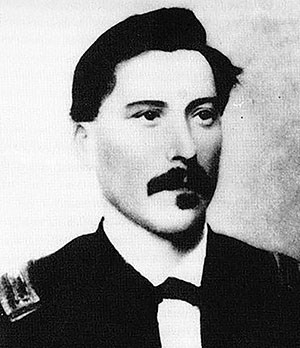Capt. Nolan also helped them improve their shooting skills by purchasing ammunition with his own money so they could have daily target practice. At the time the Army did not allow ammunition, or time, for men to improve their shooting skills since it was something most men already knew how to do. While some of the men in Co. A were Civil War veterans who would have had some experience with guns, there were some former slaves in the company who would have never had a chance to hold a gun, much less shoot one, until now.
By all accounts the men acquitted themselves well in battle and worked hard at whatever duties they were assigned. They also did their best to deal with the loneliness and hardships of frontier duty. For the men of Co. A those hardships were compounded by the racism that was common during that time. In fact, that racism would eventually lead to their transfer from the post.
On January 2, 1869, the Cavalry stables at the fort burned, killing 39 horses and destroying the grain, saddles and ammunition stored there. It’s possible that it was the result of a fight between three troopers from the 10th and some white soldiers from the 3rd Infantry at the sutler’s store the day before. That’s only speculation, though. The cause was never determined for sure since the post commander at the time, Maj. Yard, choose not to investigate. Instead, he sent the 10th to Fort Zarah to avoid any more trouble. This incident would actually have an effect on Capt. Nolan’s career.
Nicholas Nolan was born in Ireland on March 10, 1835, and came to the U.S. before the Civil War. He joined the Army in 1852, starting out as an artilleryman in the 2nd Dragoons. He eventually rose to the rank of First Sergeant before receiving a commission as a 2nd Lieutenant in the 6th US Cavalry. Lt. Nolan had a distinguished record with the 6th, being present for duty for most of the battles they fought. He was wounded twice, once lightly at the Battle of Fairfield and then seriously at the Battle of Dinwiddie Court House. He received two brevet promotions and numerous citations for gallantry and bravery in action.
After the Civil War, Nolan accepted a commission as Captain in the 10th Cavalry. Although there was some stigma attached to White officers who choose to command Black troops, the promotion opportunities were often much better. Many officers could wait 10 years or more for a promotion to the next rank in the post-Civil War Army so many decided a little social stigma was worth the chance for quicker advancement.
Despite his stellar record during the Civil War, Nolan had some trouble in the frontier Army. In January of 1869 he was charged with inhumane treatment of the soldiers under his command and was ordered to appear before a board in Washington, DC to answer the charges, which were dismissed.
In the same month, a Board of Survey convened at Fort Larned to investigate the circumstances of the cavalry stables’ fire and assigned responsibility for the loss of the government property, valued at $5,085.93, to Capt. Nolan. The recommendation worked its way through Army command channels until it was endorsed by Office of the Secretary of War, which ordered his pay stopped until the amount was paid back. He would eventually have the decision reversed have all his pay restored.
Nolan would continue to serve in the Army, eventually becoming a Major in the 3rd Cavalry in December of 1882. Only a year later he would die in October of 1883 in Holbrook, Arizona, at the relatively young age of 48.
The burning of the cavalry stables at Fort Larned, and the circumstances surrounding it, highlighted the difficulty the frontier Army had in integrating the African American troops who chose a military career after the Civil War. More often than not, when there was trouble between White and Black troops, the Army’s response was usually to remove the Black troops from the area rather than deal with the situation. Despite these hardships, the Buffalo Soldiers served with distinction throughout the Indians Wars.

